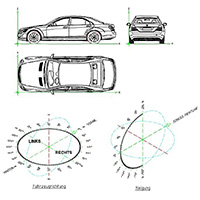Initially the original European standard for testing of armored vehicles was BRV 1999. In 2009 it was superseded by a new standard, BRV 2009.
BRV 2009 specifies much stricter requirements than BRV 1999: the main difference between these guidelines is that according to VPAM 1999 a vehicle can be shot at 45° or 90° only. According to VPAM 2009 the vehicle can be shot at ANY angle, which makes it much more challenging, but on the other hand much closer to the real life.
ERV 2010
Also the new standard ERV 2010 increased the requirements for the protection against side blasts – originally the requirement was to sustain a blast of 15 kg TNT from a distance of 4 m. The charge was put on the ground level.
The new requirement prescribes the detonation of the same amount of TNT, 15 kg, but from a distance of 2m. The power of explosion reduces exponentially with the distance so it makes a big difference.
Moreover, the charge is placed at the height of 1m. This requirement is much more difficult to fulfill as the blast wave is directed to the center of the B-pillar of a vehicle now and not under the vehicle.
Also for testing our vehicle we decided to make the blast directional – this is achieved with a help of heavy metal block which reflects the whole blast wave towards the vehicle, thus the impact is much stronger.
The difference in the explosion significance is well seen here - this vehicle is after a 15 kg TNT non-directional blast from 4 m - the damage to the vehicle is moderate - and this is our vehicle after 15 kg TNT directional blast from 2 m. The vehicle was pushed by more than a meter away and the standard car body in the middle was completely stripped off.


